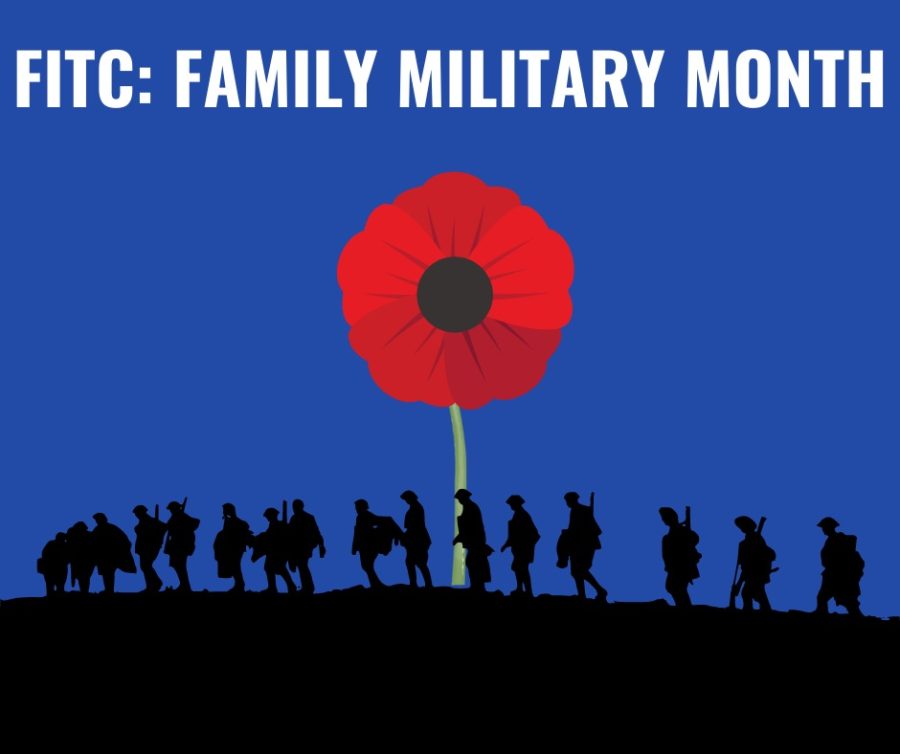Family Military Month
November 23, 2021
There are 2,233,050 members in the U.S. military, people who choose every day to be there for their country. November is Family Military Month, a month that acknowledges the changes and challenges families encounter together as a loved one is serving.
Today, there are nearly 1.2 million children of active duty military members worldwide.
Junior Callie Parker is one of them. Her father has been in the air force for about 18 years.
Being a child of an active duty serviceman, Parker knows the consistent movement that comes with being a “military brat.” According to Parker, adjusting to each new location is something that can be tough.
“I think when I was younger, it was a lot easier because I was homeschooled for a lot of my life, and I could just plug in wherever, but it is harder when you are older and have stronger relationships and you have to leave,” Parker said. “ But, you get used to it somewhat, knowing you have to keep going.”
On average, a child with parents in the military will move six to nine times in their school education.
Parker spent two years of her life in Korea, an experience she said she truly enjoyed being a part of.
“It was fun, I got to see a lot of new things,” she said.
Amy Boswell teaches English, personal finance and econ. Boswell not only knows what it is like to be a child of a military member, but a spouse of one, too.
“My stepfather was in the army,” Boswell said. “My husband was also in the military. He was in the Navy.”
Boswell says military spouses go through a lot of life’s milestones alone.
“It is hard because they are supposed to be your lifetime partner,” she said.
Boswell’s husband was unable to attend her college graduation. She decided she wouldn’t walk the stage because he wouldn’t be there to watch.
While being a spouse of a military member, fear of your partner’s safety is a common emotion to experience. A specific moment that was difficult for Boswell was once on the news where a sailor on her husband’s ship was overboard and missing, and without much ability to contact her husband, that led to lingering conclusions.
“I assumed it wasn’t him because no one had contacted me, but I still didn’t know,” she said. “I didn’t know if it was someone who he was close to or someone that I knew.”
In order to be a military spouse, Boswell says it is important to learn to be self-sufficient.
“You have to have a person who is really willing to be strong and independent and do everything on their own,” Boswell said. “I had to run the household while my husband was gone and do everything, I was in charge of the house, the lawn, the cars, everything.”
While in Hawaii with her husband on one of his deployments, Boswell worked with military spouses and couples alike. She also mentions that through that experience, she was able to witness the high rate of divorce. That rate for the entire U.S. military averages out to about 3.7%.
Despite her husband now being retired, Boswell still values the lessons she was able to learn about herself.
“I know I can take care of myself,” she said. “I know I can do it. I can do anything.”
English teacher Curtis Hammill served for five years in the U.S. Marines. As an AM Tracker, Hammill would drive the amphibious assault tank that sat in the water and would load up combat troops. Then driving from the beach to the ocean onto the back of the boat while it was still moving. As the boat approached the shore, Hammill would be in charge of driving the tank again onto the ocean then to the shore so that the soldiers could perform their operation.
“It’s definitely different and very interesting,” he said.
Originally playing college basketball, Hammill quickly realized it wasn’t for him. Instead, he joined the Marines,where his brother (total served 11 years as part of the infantry and as a tank commander) at the time was about two years in.
“I think I was a little naive about how the world worked and how I thought basketball should work,” Hammill said. “I’ve always had a strong love for people, so it always made sense that I follow in the footsteps of my brother and join the Marine Corps.”
The Marine Corps celebrated their 246th birthday on November 10th.
With the holidays, members of the military often aren’t able to make it home.
“I think I missed three Christmases just being somewhere else. It’s pretty not sad, but lonely maybe,” Hammill said. “But I almost think, with everyone being together, that’s what gives you a second kind of family. Everything that’s bad happens to us all together, I think it’s (the situation of not being around family for the holidays) is easier to cope with because we’ve all shared suffering. And I think that makes the moments coming home to family even sweeter.”
Hammill initially started his series of deployments in San Diego, following with Japan, Singapore, Hong Kong, and the Philippines.
Not only do military families face obstacles during their loved ones’ service, but post service holds its own challenges as well. Afterwards, leaving many veterans with higher divorce
rates, poorer mental health, and higher suicide rates. Specifically those who were deployed. Along with behavioral issues that some children of deployed soldiers may inhabit.
“You can’t just jump back in where you left off necessarily when you get home again, it’s a transition,” Hammill said.
Families of service members experience a unique and underappreciated journey of life being indirectly a part of the US military.
“Military family month is an important reminder that the military member is not the only one making sacrifices for our country. Recognizing military families is also important for the military member, who is often worrying about the care of their family when they are deployed,” Boswell said. “Military families are unique, strong, and independent. I thank them and I am proud to be from a military family.”









